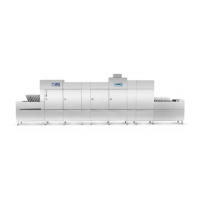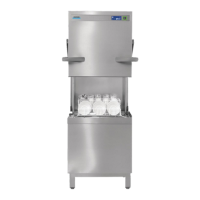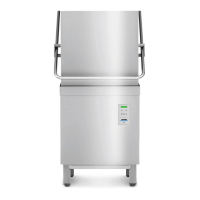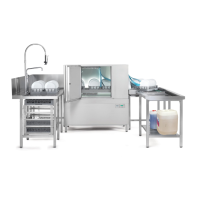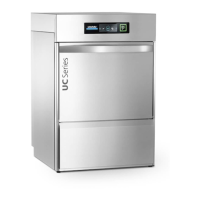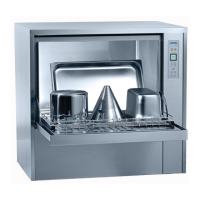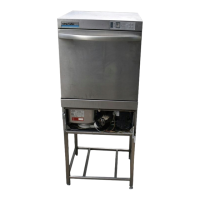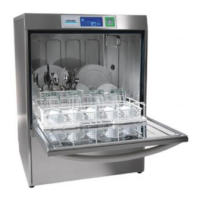Organisation of the washing process
10 Organisation of the washing process
MTR and MTF series machines fulfil the requirements of DIN 10510 (“Food hygiene – Commercial
dishwashing with multitank-transport dishwashers – Hygiene requirements, procedure testing”).
You should observe some organisational aspects to enable these machines to achieve hygienically correct
results. Additional information is also contained in the leaflets produced by the VGG (Verband der Hersteller
von gewerblichen Geschirrspülmaschinen e.V. / Association of Manufacturers of Commercial Dishwashing
Machines, based in Hagen, Germany; www.vgg-online.de).
Structural requirements
The washing area must be separate from the food preparation areas.
The “clean” side must be separated from the “dirty” side, to prevent the cleaned crockery from becoming
soiled again.
The transport paths for dirty and clean crockery must not intersect.
The air admission system must be designed to avoid unduly inconveniencing the personnel.
The air for drying the dishes must have a low germ load.
Organisation
The time during which food residue can dry onto the dishes should be kept as short as possible so as to
prevent bacteria buildup and to facilitate cleaning.
Remove left-over food and waste from the crockery before you wash it.
Pre-sort the crockery.
Load the washing racks so that the crockery does not overlap. It must be possible for the water jets to
reach all surfaces. Covered surfaces cannot be cleaned.
Soak the cutlery before you wash it.
Different people must be used for loading dirty dishes into the machine and removing the cleaned
crockery from the machine.
Wait until the cleaned dishes have air dried.
Do not use tea towels.
Do not stack wet crockery.
People removing the cleaned crockery must have clean hands or wear clean gloves.
Clean and disinfect hands with soap and hand disinfectants. Use disposable hand towels.
Requirements on the dishwashing machine
The temperatures in the individual zones must be within the rated values ( 17.1). Regularly check the
temperatures ( 7.4).
Deviations are logged in the hygiene logbook ( 13.2).
The detergent concentration must be stable and sufficiently high. Follow the information provided by the
manufacturer. Regularly check the fill levels of the containers (detergent, rinse aid, disinfectant
component).
Deviations are logged in the hygiene logbook ( 13.2).
Deposits and coatings in the machine must be removed by thorough cleaning. Deposits represent a
hygiene risk, because bacteria can build up there. Eliminate the cause of the deposits.
Requirements on the dishes
Remove damaged crockery from the washing cycle.
Use crockery that has smooth surfaces.
Use crockery that does not have deep recesses, to allow the water to reach the whole of the surface
area.
Plastic crockery must be heat resistant, resistant to deformation and free from hairline cracks.
Water should be able to run off easily, so that the crockery can quickly dry by itself.
Dishes with deposits must be thoroughly cleaned because deposits can serve as a breeding ground for
bacteria. The cause of deposits must be ascertained and eliminated.

